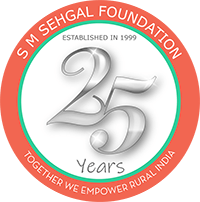Agar village is located in the Barakot block of Champawat district, Uttarakhand, at 1,770 meters above sea level. The town’s total population is 518 (268 males and 248 females). Spread over 138.97 hectares, most of the land in the village is barren. The scarcity of natural sources for irrigation has pushed the farmers to practice rain-fed agriculture in this town. Most people have migrated from the village because of the unpaved roads, the lack of sufficient water, and the destruction of crops by wild animals. The main occupation here is animal husbandry and daily wage jobs.
The women of the Agar are hardworking. Mamta Kholia is a conscientious woman who studied up to class 12. Her husband had to migrate out of town to seek employment opportunities. Mamta decided to make animal husbandry her main business to support her husband and family. She went to the forest every day to bring grass for her cows, bullocks, calves, and goats to supplement their food. She took milk to the cooperative milk society in the village, where she traded milk for enhanced income. But despite her hard work, Mamta still needed guidance to get the right price for her product.
The cow could give 6–7 liters of milk daily when healthy, but she fell ill. The doctor told Mamta that the grass from the forest and barren fields did not have the right nutrients, which deteriorated the cow’s health and resulted in low milk production. Even after treatment, the cow’s health did not improve, adversely affecting the family’s livelihood.
Mamta shared her concern in the monthly farmers’ meetings held under the HDFC Parivartan project implemented by S M Sehgal Foundation. Mamta is a member of Mahila Shakti Farmers Interest Group, organized under the project that has been trained on improved agriculture practices and balanced animal nutrition.
Mamta got the animal nutrition kit and administered the kit regularly, and deworming slowly improved her cow’s physical condition and increased her ability to eat food. The amount of fat and SNF (solids not fat) increased, allowing the cow to produce 8–9 liters of milk per day. Before, Mamta had earned Rs. 27 per liter of milk, and now the regular use of the nutrition kit has increased the fat content and milk production. Today Mamta earns Rs. 35 per liter.
The proper guidance goes a long way, and such has been the case for Mamta; this change in her life has given her the confidence to save enough, pursue higher education, and build a livelihood in animal husbandry.
(Author: Ajay Nigaltiya is field assistant, Champawat, with S M Sehgal Foundation)


